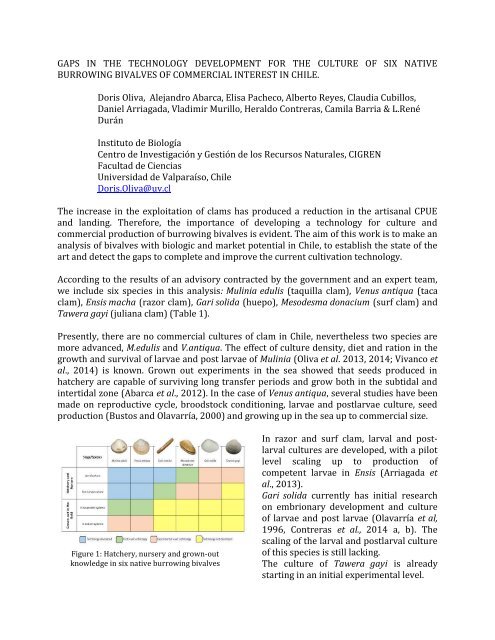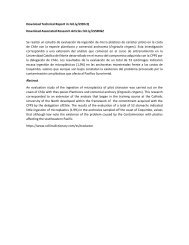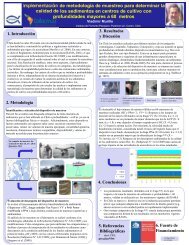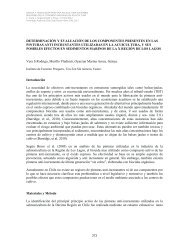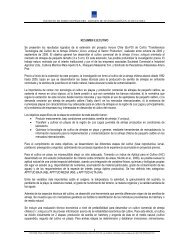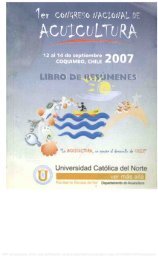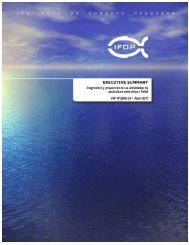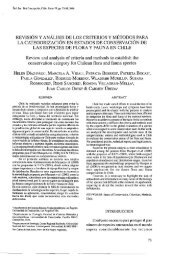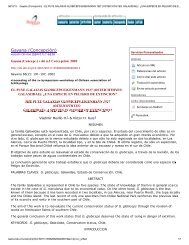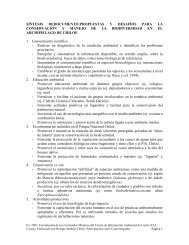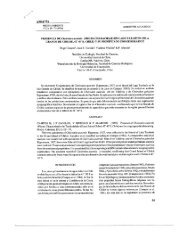GAPS IN THE TECHNOLOGY DEVELOPMENT FOR THE CULTURE OF SIX NATIVE BURROWING BIVALVES OF COMMERCIAL INTEREST IN CHILE
For more information please visit : bit.ly/2vfedz8 The increase in the exploitation of clams has produced a reduction in the artisanal CPUE and landing. Therefore, the importance of developing a technology for culture and commercial production of burrowing bivalves is evident. The aim of this work is to make an analysis of bivalves with biologic and market potential in Chile, to establish the state of the art and detect the gaps to complete and improve the current cultivation technology.
For more information please visit : bit.ly/2vfedz8
The increase in the exploitation of clams has produced a reduction in the artisanal CPUE and landing. Therefore, the importance of developing a technology for culture and commercial production of burrowing bivalves is evident. The aim of this work is to make an analysis of bivalves with biologic and market potential in Chile, to establish the state of the art and detect the gaps to complete and improve the current cultivation technology.
You also want an ePaper? Increase the reach of your titles
YUMPU automatically turns print PDFs into web optimized ePapers that Google loves.
<strong>GAPS</strong> <strong>IN</strong> <strong>THE</strong> <strong>TECHNOLOGY</strong> <strong>DEVELOPMENT</strong> <strong>FOR</strong> <strong>THE</strong> <strong>CULTURE</strong> <strong>OF</strong> <strong>SIX</strong> <strong>NATIVE</strong><br />
BURROW<strong>IN</strong>G <strong>BIVALVES</strong> <strong>OF</strong> <strong>COMMERCIAL</strong> <strong>IN</strong>TEREST <strong>IN</strong> <strong>CHILE</strong>.<br />
Doris Oliva, Alejandro Abarca, Elisa Pacheco, Alberto Reyes, Claudia Cubillos,<br />
Daniel Arriagada, Vladimir Murillo, Heraldo Contreras, Camila Barria & L.René<br />
Durán<br />
Instituto de Biología<br />
Centro de Investigación y Gestión de los Recursos Naturales, CIGREN<br />
Facultad de Ciencias<br />
Universidad de Valparaíso, Chile<br />
Doris.Oliva@uv.cl<br />
The increase in the exploitation of clams has produced a reduction in the artisanal CPUE<br />
and landing. Therefore, the importance of developing a technology for culture and<br />
commercial production of burrowing bivalves is evident. The aim of this work is to make an<br />
analysis of bivalves with biologic and market potential in Chile, to establish the state of the<br />
art and detect the gaps to complete and improve the current cultivation technology.<br />
According to the results of an advisory contracted by the government and an expert team,<br />
we include six species in this analysis: Mulinia edulis (taquilla clam), Venus antiqua (taca<br />
clam), Ensis macha (razor clam), Gari solida (huepo), Mesodesma donacium (surf clam) and<br />
Tawera gayi (juliana clam) (Table 1).<br />
Presently, there are no commercial cultures of clam in Chile, nevertheless two species are<br />
more advanced, M.edulis and V.antiqua. The effect of culture density, diet and ration in the<br />
growth and survival of larvae and post larvae of Mulinia (Oliva et al. 2013, 2014; Vivanco et<br />
al., 2014) is known. Grown out experiments in the sea showed that seeds produced in<br />
hatchery are capable of surviving long transfer periods and grow both in the subtidal and<br />
intertidal zone (Abarca et al., 2012). In the case of Venus antiqua, several studies have been<br />
made on reproductive cycle, broodstock conditioning, larvae and postlarvae culture, seed<br />
production (Bustos and Olavarría, 2000) and growing up in the sea up to commercial size.<br />
Figure 1: Hatchery, nursery and grown-out<br />
knowledge in six native burrowing bivalves<br />
In razor and surf clam, larval and postlarval<br />
cultures are developed, with a pilot<br />
level scaling up to production of<br />
competent larvae in Ensis (Arriagada et<br />
al., 2013).<br />
Gari solida currently has initial research<br />
on embrionary development and culture<br />
of larvae and post larvae (Olavarría et al,<br />
1996, Contreras et al., 2014 a, b). The<br />
scaling of the larval and postlarval culture<br />
of this species is still lacking.<br />
The culture of Tawera gayi is already<br />
starting in an initial experimental level.


